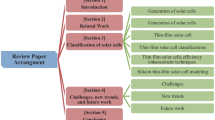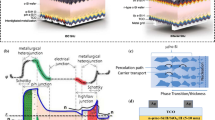Abstract
In this paper, a simulation for interdigitated back-contact (IBC) silicon solar cells was performed by using Silvaco TCAD ATLAS to investigate the cell’s electrical properties. The impacts of various parameters, including the depth of the front surface field(FSF), the FSF peak doping concentration, the depths of the emitter and the back surface field(BSF), the peak doping concentrations of the emitter and BSF, the base doping, and the bulk lifetime on the output characteristics like the light current-voltage curves and the internal quantum efficiency of the IBC solar cell, were investigated. The light absorption was determined by adjusting the antireflection coating and the Al thickness. The FSF must be thin and have a low doping concentration for high-efficiency IBC cells. If the conversion efficiency is to be improved, a thick emitter and a high doping concentration are needed. Because of the low resistivity of the Si substrate, the series resistance was reduced, but recombination was increased. With a high-resistivity Si substrate, the opposite trends were observed. By counter-balancing the series resistance and the recombination, we determined by simulation that the optimized resistivity for the IBC cells was 1 Ω·cm. Because all metal electrodes in the IBC cells are located on the back side, a higher minority carrier lifetime showed a higher efficiency. After the various parameters had been optimized, texturing and surface recombination were added into the simulation. The simulated IBC cells showed a short-circuit current density of 42.89 mA/cm2, an open-circuit voltage of 714.8 mV, a fill factor of 84.04%, and a conversion efficiency of 25.77%.
Similar content being viewed by others
References
J. Zhao, A. Wang, P. P. Altermatt, S. R. Wenham and M. A. Green, in Proceedings of the 1st World Conference on Photovoltaic Energy Conversion (Waikoloa, USA, December 5–9, 1994), p. 1477.
P. J. Cousins, D. D. Smith, L. Hsin-Chiao, J. Manning, T. D. Dennis, A. Waldhauer, K. E. Wilson, G. Harley and W. P. Mulligan, in Proceedings of the 35th Photovoltaic Specialists Conference (Honolulu, USA, June 20–25, 2010), p. 275.
R. M. Swanson, Sol. Cells 17, 85 (1986).
R. A. Sinton, P. J. Verlinden, R. A. Crane, R. M. Swanson, C. Tilford, J. Perkins and K. Garrison, in Proceedings of the 23rd IEEE Photovoltaic Specialists Conference (Louisville, USA May 10–14, 1993), p. 157.
R. Woehl, J. Krause, F. Granek and D. Biro, IEEE Electr. Dev. L. 32, 345 (2011).
T. Kinoshita et al., in Proceedings of the 26th European Photovoltaic Solar Energy Conferenceb (Amsterdam, Netherlands, September 5–9, 2011), p. 871.
M. A. Green, K. Emery, Y. Hishikawa, W. Warta and E. D. Dunlop, Prog. Photovoltaics 20, 606 (2012).
D. S. Kim, V. Meemongkolkiat, A. Ebong, B. Rounsaville, V. Upadhyaya, A. Das and A. Rohatgi, in Proceedings of the 1st World Conference on Photovoltaic Energy Conversion (Waikoloa, USA, December 5–9, 1994), p. 1417.
O. Nichiporuk, A. Kaminski, V. Skryshevsky and S. Litvinenko, Sol. Energ. Mat. Sol. Cells 87, 549 (2005).
O. Nichiporuk, A. Kaminski, M. Lemiti, A. Fave and V. Skryshevsky, Sol. Energ. Mat. Sol. Cells 86, 517 (2005).
T. Nagashima, K. Hokoi, K. Okumura and M. Yamaguchi, in Proceedings of the 20th European Photovoltaic Solar Energy Conference (Barcelona, Spain, June 6–10, 2005), p. 163.
E. Van Kerschaver and G. Beaucarne, Prog. Photovoltaics 14, 107 (2006).
S. Michael and A. Bates, Sol. Energ. Mat. Sol. Cells 87, 785 (2005).
M. G. Kang, S. Tark, J. C. Lee, C.-S. Son and D. Kim, J. Cryst. Growth 326, 14 (2011).
G. Heiser, A. G. Aberle, S. R.Wenham and M. A. Green, Microelectr. J. 26, 273 (1995).
R. R. King, R. A. Sinton and R. M. Swanson, IEEE T. Electron Dev. 37, 365 (1990).
R. R. King and R. M. Swanson, IEEE T. Electron Dev. 38, 1399 (1991).
Author information
Authors and Affiliations
Corresponding author
Rights and permissions
About this article
Cite this article
Kang, M.G., Song, He., Kim, S.M. et al. A simulation study on the electrical structure of interdigitated back-contact silicon solar cells. Journal of the Korean Physical Society 66, 1521–1526 (2015). https://doi.org/10.3938/jkps.66.1521
Received:
Accepted:
Published:
Issue Date:
DOI: https://doi.org/10.3938/jkps.66.1521




